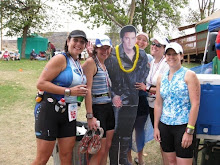So she did a workout of five progressively faster one-mile repeats starting at 5:30 pace to remind herself that she could be competitive. "When I ran the last mile of the workout in 5:07, I knew that if someone threw down a fast mile in the race, I'd be okay," says Rothstein, who finished second in 1:08:26.
"A lot of confidence is built by overcoming fears," says Peter Gilmore, a 2:12-marathoner and online coach (infiniterunning.com). "These sessions show that you're physically capable, so mentally you become more self-assured on race day." Typically, competitors use confidence-building workouts every week in the four to six weeks before an event, but you can also use them throughout your training to boost belief in your abilities.
When you head out to banish fears, pay attention to how you feel. If it's not your day, bag it. "A bad day just means you're human," says Stan Beecham, Psy.D., a sports psychologist who works with elite runners.
If a workout bombs, don't try a redo, which can heighten anxiety. Instead, reboot your confidence with something different. "If you had a bad track session, do a tempo run; if your long run was debilitating, knock out 800s at the track," says Gilmore. "You'll gain the benefits of the workout, and put confidence back in power." Here's how:
The Fear: Not Finishing
New distances can intimidate runners. To move beyond the fear of the unknown, focus on volume with long runs that extend beyond race distance (except for marathoners). "Physically, it's essential," says Gilmore, "and mentally, you see that you can accomplish it."The Workout: Long Runs
Complete three long runs that are one to two miles longer than your goal race distance (22 miles for the marathon). One run proves you can do it; three seals the deal. Slow the pace so you end strong—another confidence-booster, says Gilmore.
The Fear: Starting too Fast
"No matter how experienced you are, it's easy to get caught up in the energy of a race and go out faster than planned," says Gilmore. To learn to resist that temptation, practice nailing—not exceeding—your goal pace at the beginning of a workout, rather than at the more conventional middle or end. This gives a sense of how the pace feels when you're fresh.The Workout: Race-Pace Miles
Half and full marathoners should run three to six miles at target race pace (warm up and cool down with a two-mile jog). Those preparing for a 10K should run 2 to 3 x 1 mile at goal pace with a 90-second recovery; 5K runners should do one mile at race pace, followed by a 400-meter recovery, then 2 x 800 at race pace with a 90-second recovery, says Gilmore.
The Fear: Tough Terrain
Up. Down. Innocuous words—except when they're describing a race course. Counter your terror with practice runs. "Find out the elevation gains and losses of your race online, then find roads that mimic them," says Gilmore.The Workout: Simulation Runs
Long runs make the best simulation runs because they allow you to practice more of the course profile, says Gilmore. If your target race is hilly and local hills are in short supply, do repeats on the nearest bridge or parking garage: six to 10 one-to four-minute climbs at a strong pace.
The Fear: Slowing Down
The final miles of a race can pose a real physical and mental barrier. Break it down by doing tempo runs and long runs back-to-back. "The stamina you build will help erase the fear of fading," says Andrew Kastor, coach of the High Sierra Striders in Mammoth Lakes, California.The Workout: Back-to-Back Tempo and Long Runs
Do a tempo run at half-marathon or slightly faster pace on Saturday, and a long run at a comfortable, steady pace on Sunday. Those targeting 5K and 10K should run a two- to four-mile tempo run, followed by a four- to eight-mile long run. Half and full marathoners should do five to six miles at tempo, followed by an 11- to 13-mile (half-marathon) or 20- to 22-mile (marathon) long run.





















No comments:
Post a Comment